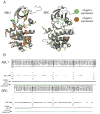An Open Library of Human Kinase Domain Constructs for Automated Bacterial Expression
- PMID: 30004690
- PMCID: PMC6081246
- DOI: 10.1021/acs.biochem.7b01081
An Open Library of Human Kinase Domain Constructs for Automated Bacterial Expression
Abstract
Kinases play a critical role in cellular signaling and are dysregulated in a number of diseases, such as cancer, diabetes, and neurodegeneration. Therapeutics targeting kinases currently account for roughly 50% of cancer drug discovery efforts. The ability to explore human kinase biochemistry and biophysics in the laboratory is essential to designing selective inhibitors and studying drug resistance. Bacterial expression systems are superior to insect or mammalian cells in terms of simplicity and cost effectiveness but have historically struggled with human kinase expression. Following the discovery that phosphatase coexpression produced high yields of Src and Abl kinase domains in bacteria, we have generated a library of 52 His-tagged human kinase domain constructs that express above 2 μg/mL of culture in an automated bacterial expression system utilizing phosphatase coexpression (YopH for Tyr kinases and lambda for Ser/Thr kinases). Here, we report a structural bioinformatics approach to identifying kinase domain constructs previously expressed in bacteria and likely to express well in our protocol, experiments demonstrating our simple construct selection strategy selects constructs with good expression yields in a test of 84 potential kinase domain boundaries for Abl, and yields from a high-throughput expression screen of 96 human kinase constructs. Using a fluorescence-based thermostability assay and a fluorescent ATP-competitive inhibitor, we show that the highest-expressing kinases are folded and have well-formed ATP binding sites. We also demonstrate that these constructs can enable characterization of clinical mutations by expressing a panel of 48 Src and 46 Abl mutations. The wild-type kinase construct library is available publicly via Addgene.
Figures






References
-
- Manning G, Whyte DB, Martinez R, Hunter T, Sudarsanam S. Science. 2002;298:1912–1934. - PubMed
-
- Hunter T, Manning G. In: Receptor Tyrosine Kinases: Structure, Functions and Role in Human Disease. Wheeler DL, Yarden Y, editors. Springer; New York: New York, NY: 2015. pp. 1–15.
-
- American Cancer Society. Cancer Facts & Figures 2015. 2015.
-
- Cohen P, Tcherpakov M. Cell. 2010;143:686–693. - PubMed
Publication types
MeSH terms
Substances
Grants and funding
LinkOut - more resources
Full Text Sources
Other Literature Sources
Research Materials
Miscellaneous

